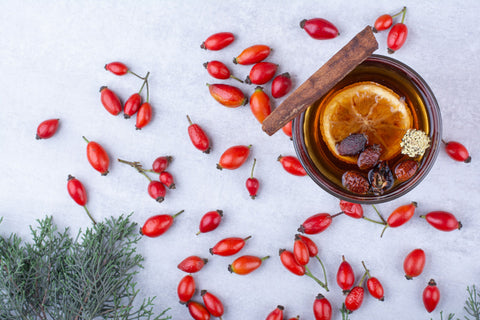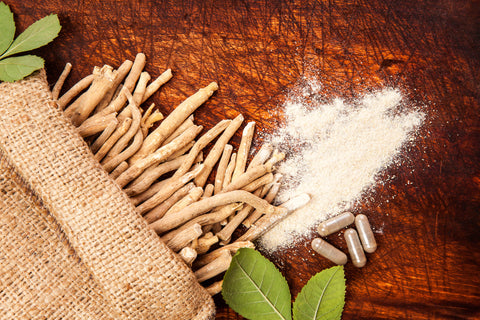Rosehip (Rose Hip) And Joint Health
Rose hips (rosehips) are the fruits (usually red) that develop on rose bushes after the flower petals drop off. Rose hips are edible and for centuries they were regularly consumed by native people of North America where roses were found growing wild. Although rose hip seeds, like other fruits seeds, contain some cyanide yet one would have to consume them in large amounts to develop dangerous side effects.
The wild rose (Rosa canina), also called dog rose, produces the largest and most valued fruits.
Nutritional Content
Wild rose may contain hundreds times as much vitamin C as oranges. They are also rich in bioflavonoids that help enhance effectiveness of vitamin C, and have long been used in folk medicine to strengthen blood vessels or prevent colds. Rose hips also contain flavonoids, phenols, lycopene, ellagic acid, vitamin E, beta carotene, manganese, vitamin K, and even fatty acids.

Arthritis
Rose hips from Rosa canina (dog rose) have been shown to alleviate arthritis symptoms when taken on a daily basis. It alleviates joint pain through its immunosuppressive effects as human immune system contributes to not only rheumatoid arthritis (autoimmune condition in which immune system sends antibodies against joints) but also to the osteoarthritis. An inflammatory cytokine called Interleukin 1-Beta (IL-1β) stimulates cartilage cells to make proteins that break down join tissue. Normally (in moderation), this process encourages cell turnover, but in excess, it contributes to chronic joint cartilage degradation.
Although rose hip doesn’t seem to reduce IL-1β levels, yet it has been shown to block the activation of proteins in cartilage cells that can lead to unhealthy degradation of joint tissue.
Rose hip has anti-inflammatory and immunosuppressive properties also by decreasing chemotaxis (transportation of immune cells into tissue).
The key active ingredient in Rosehip which is responsible for helping recover, or at least reduce symptoms of arthritis, is a fat-soluble galactolipid compound called GOPO.
I personally know individuals who told me they completely recovered from arthritis by taking a good quality rose hip powders or supplements.
As arthritis remedy rose hip was evaluated in 1980s by Danish farmer Erik Hansen who suffered from osteoarthritis. After conventional medicine failed to help, he decided to try some natural remedies and found out that rose hip jam was very helpful. After eating it regularly, his arthritis began to improve. So he decided to create a more concentrated version of it by drying and grinding wild rose hips into a powder. Within a month of taking the powder, his pain disappeared. After his recovery Hansen began selling the rose hip powder to arthritis sufferers all over Denmark. The results were so good that eventually the researchers at the Copenhagen University Department of Clinical Microbiology decided to analyse rose hips. They identified the active compound in the rose hip responsible for the positive results and named it GOPO. They also found that its content in wild rose hips varies considerably in different species.
The remedy should be made from a rose hip subspecies of a special type of dog rose (Rosa canina), as it has been shown in various pharmacological studies, as well as clinical trials, to have anti-inflammatory properties and very beneficial for people with osteoarthritic pain.
Danish researchers found the specially cultivated compound reduced nagging pain in 9 out of 10 people who took part in clinical trials. The results of studies carried out at Frederiksberg University in Copenhagen and published in the Open Journal of Rheumatology and Autoimmune Disease show the curing effect of rose hip extract. According to the lead researcher Kaj Winther, “GOPO has been shown to anti-inflammatory and chondroprotective activity, helping to protect and repair joint cartilage even at low concentrations.”

Obesity
The researchers found that daily intake of rose hip extract significantly reduced abdominal fat area; abdominal visceral fat area; body weight; and body mass index.
Anti-Ageing
According to a randomized, double-blind clinical study published in 2015 in the journal Clinical Interventions participants on rose hip showed significant improvements in wrinkles, skin moisture and elasticity.
Cell Proliferation
Breast cells treated with rosehip extracts demonstrated a significant decrease in cell proliferation.
Other Benefits
Preliminary evidence also suggests rose hip may be beneficial to people with diabetes, high blood pressure and high cholesterol.
Using Rose Hip With Other Arthritis Supplements
Because rosehip works through different mechanism than glucosamine and other joint remedies or supplements, you can add it to your current supplementation regimen for enhanced results.
Side Effects
When taken in appropriate doses by mouth, rose hip typically does not have any unwanted side effects. Doses as high as 40 grams per day have been studied. Intestinal distress is the most common side effect of high doses.
Some species of the Rosacea (rose) family contain cyanogenic glycosides, which produce toxic hydrogen cyanide. Also rose hip seeds can contain some cyanide, and for this reason it’s better to remove the seeds.
Other commonly consumed by us fruits, including apples, also contain seeds with cyanide. If we eat a few seeds from time to time, it’s not harmful, but we should avoid large quantities.
So, although rose hip seeds contain some cyanide there is no need to worry if you have some fruits with seeds because you would have to consume very large amounts of the seeds (probably impossible to consume) to develop dangerous effects.
Contraindications & Interactions
Although interactions with rose hip are not well documented, as a precaution, it is rather not recommended for pregnant and breastfeeding women; people with excessive blood clotting (rose hips contain rugosin E, which is believed to increase blood clotting), sickle cell disease; and those with glucose-6-phosphate dehydrogenase deficiency (G6PD deficiency).
Sources
- J Nat Prod 2003; 66(7): 994-5
- Phytomed 2004; 11: 383-91
- https://www.drugs.com/npp/rose-hips.html
- Curr Ther Res Clin Exp 2003; 64(1): 21-31
- Scand J Rheumatol 2005: 34: 302-8
- https://draxe.com/rose-hips/
- Andersson U, Berger K, Högberg A, Landin-Olsson M, Holm C. Effects of rose hip intake on risk markers of type 2 diabetes and cardiovascular disease: a randomized, double-blind, cross-over investigation in obese persons. Eur J Clin Nutr. 2012;66(5):585-590.22166897
- Cameron M, Gagnier JJ, Little CV, Parsons TJ, Blümle A, Chrubasik S. Evidence of effectiveness of herbal medicinal products in the treatment of arthritis. part I: osteoarthritis. Phytother Res. 2009;23(11):1497-1515.19856319
- Christensen R, Bartels EM, Altman RD, Astrup A, Bliddal H. Does the hip powder of Rosa canina (rosehip) reduce pain in osteoarthritis patients?—a meta-analysis of randomized controlled trials. Osteoarthritis Cartilage. 2008;16(9):965-972.18407528
- Chrubasik C, Duke RK, Chrubasik S. The evidence for clinical efficacy of rose hip and seed: a systematic review. Phytother Res. 2006;20(1):1-3.16395741
- Chrubasik C, Roufogalis BD, Müller-Ladner U, Chrubasik S. A systematic review on the Rosa canina effect and efficacy profiles. Phytother Res. 2008;22(6):725-733.18384191
- Chrubasik-Hausmann S, Chrubasik C, Neumann E, Muller-Ladner U. A pilot study on the effectiveness of a rose hip shell powder in patients suffering from chronic musculoskeletal pain. Phytother Res. 2014;28(11):1720-1726.25043856
- Fresz T, Nagy E, Hilbert A, Tomcsanyi J. The role of flavonoids in false positive digoxin assays caused by the consumption of hibiscus flower and rose hip tea. Int J Cardiol. 2014;171(2):273-274.24365615
- Horváth G, Molnár P, Radó-Turcsi E, et al. Carotenoid composition and in vitro pharmacological activity of rose hips. Acta Biochim Pol. 2012;59(1):129-132.22428123
- Jäger AK, Eldeen IM, van Staden J. COX-1 and -2 activity of rose hip. Phytother Res. 2007;21(12):1251-1252.17639563
- Kharazmi A, Winther K. Rose hip inhibits chemotaxis and chemiluminescence of human peripheral blood neutrophils in vitro and reduces certain inflammatory parameters in vivo. Inflammopharmacology. 1999;7(4):377-386.17657440
- Kirkeskov B, Christensen R, Bügel S, et al. The effects of rose hip (Rosa canina) on plasma antioxidative activity and C-reactive protein in patients with rheumatoid arthritis and normal controls: a prospective cohort study. Phytomedicine. 2011;18(11):953-958.21420288
- Lattanzio F, Greco E, Carretta D, Cervellati R, Govoni P, Speroni E. In vivo anti-inflammatory effect of Rosa canina L. extract. J Ethnopharmacol. 2011;137(1):880-885.21771653
- Mandade RJ, Choudhury A, Harsulkar A, Wakade R. Role of the Rosa canina L. leaf extract as an antidiarrheal drug in rodents. Indian J Pharmacol. 2011;43(3):316-319.21713098
- Rein E, Kharazmi A, Winther K. A herbal remedy, Hyben Vital (stand. powder of a subspecies of Rosa canina fruits), reduces pain and improves general wellbeing in patients with osteoarthritis—a double-blind, placebo-controlled, randomised trial. Phytomedicine. 2004;11(5):383-391.15330493
- Saaby L, Jäger AK, Moesby L, Hansen EW, Christensen SB. Isolation of immunomodulatory triterpene acids from a standardized rose hip powder (Rosa canina L.). Phytother Res. 2011;25(2):195-201.20632303
- Shakibaei M, Allaway D, Nebrich S, Mobasheri A. Botanical extracts from rosehip (Rosa canina), willow bark (Salix alba), and nettle leaf (Urtica dioica) suppress IL-1β-induced NF-κB activation in canine articular chondrocytes. Evid Based Complement Alternat Med. 2012;2012:509383.22474508
- Tayefi-Nasrabadi H, Sadigh-Eteghad S, Aghdam Z. The effects of the hydroalcohol extract of Rosa canina L. fruit on experimentally nephrolithiasic Wistar rats. Phytother Res. 2012;26(1):78-85.21544885
- Tumbas VT, Canadanovic-Brunet JM, Cetojevic-Simin DD, Cetkovic GS, Ethilas SM, Gille L. Effect of rosehip (Rosa canina L.) phytochemicals on stable free radicals and human cancer cells. J Sci Food Agric. 2012;92(6):1273-1281.22083314
- Venkatesh RP, Ramaesh K, Browne B. Rose-hip keratitis. Eye (Lond). 2005;19(5):595-596.15467705
- Wenzig EM, Widowitz U, Kunert O, et al. Phytochemical composition and in vitro pharmacological activity of two rose hip (Rosa canina L.) preparations. Phytomedicine. 2008;15(10):826-835.18707854
- Wichtl M, ed. Herbal Drugs and Phytopharmaceuticals: A Handbook for Practice on a Scientific Basis. 2nd ed. Bisset NG, trans-ed. Boca Raton, FL: CRC press; 1994.
- Widén C, Ekholm A, Coleman MD, Renvert S, Rumpunen K. Erythrocyte antioxidant protection of rose hips (Rosa spp.). Oxid Med Cell Longev. 2012;2012:621579.22829958
- Winther K, Apel K, Thamsborg G. A powder made from seeds and shells of a rose-hip subspecies (Rosa canina) reduces symptoms of knee and hip osteoarthritis: a randomized, double-blind, placebo-controlled clinical trial. Scand J Rheumatol. 2005;34(4):302-308.16195164
- Winther K, Rein E, Kharazmi A. The anti-inflammatory properties of rose-hip. Inflammopharmacology. 1999;7(1):63-68.1765744
- Yi O, Jovel EM, Towers GH, Wahbe TR, Cho D. Antioxidant and antimicrobial activities of native Rosa sp. from British Columbia, Canada. Int J Food Sci Nutr. 2007;58(3):178-189.17514536
- Image credits: Image by azerbaijan_stockers on Freepik
Any information or product suggested on this website is not intended to diagnose, treat, cure or prevent any medical condition. Never disregard medical advice or delay in seeking it because of something you have read on this website. Consult your primary healthcare physician before using any supplements or making any changes to your regime.





